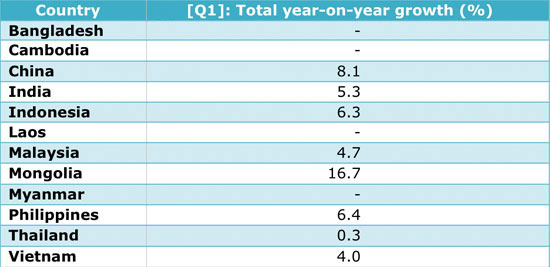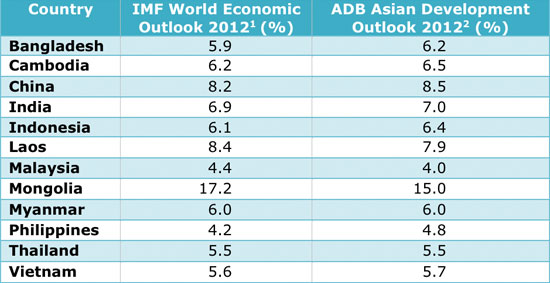Emerging Asia Looking Attractive As China Data Looks “Rushed”
Indonesia, Thailand, Philippines and India all star as China begins to create statistical anomalies
Op-Ed Commentary: Chris Devonshire-Ellis
Aug. 20 – As Emerging Asia releases its Q1 figures, there are a whole bunch of stats that spring out, not least the continuing GDP growth throughout the region. However, digging deeper, some surprising trends seem to be developing concerning China and the neighboring countries that are increasingly competing with it. I’m the first to admit I’m not an economist, so readers may just take this as a finger held in the breeze. However that does come with some 25 years of Asian experience, and what follows are my gut feelings, an analysis of the stats we have, and some nose to the ground research. I do use such personal views to plan ahead Dezan Shira’s own investments into Asia, accordingly some of our readers may also be interested to know where I feel the wind is blowing. Make of it what you will.
The GDP stats first:
It’s important to note that some of the less advanced nations do not produce timely data, hence the omissions of some of these. China’s growth, at 8.1 percent, is beginning to seem however rather like a scratched record – something we’ll come back to later. Of note however are the healthy performances of Indonesia and India – the latter despite a never ending stream of negative press still managing a respectable 5.3 percent – while Indonesia – rather like Mongolia but with palm trees – lead the way with growth of 6.3 percent and a whopping 16.6 percent respectively – although part of Mongolia’s gloss can be discounted due to the relatively small size of the latent economy. The Philippines, itself the new darling of Business Process Outsourcing, and to some extent Vietnam, both seem attractive although I have some doubts concerning the latter as we will discuss.
We can see how actual performance (above) compares with the predictions of two of the World monitors below:
Note the Philippines has bucked the trend, while all other countries are lagging behind – although to be fair, some of the major drivers in these economies – export harvest crops – have yet to appear on the balance sheet. There may be a China related concern about Vietnam however. Achieving 4 percent growth in Q1 against an annual expectation of just under 6 percent is not so hot, and with the country a major manufacturing source for products destined for China’s consumer market, the Vietnamese figures could themselves indicate that China’s planned consumer growth is stalling. It’s one to watch in terms of China’s own economic performance and may be used as a benchmark against the possibility of deliberately massaged positive data from China’s Statistics Bureau.
Quarter On Quarter (QQ) Growth – It’s Thailand?
Where it starts to get interesting is to dig deeper and try and extrapolate results for the QQ rate (quarter over quarter) which gives a micro view of what’s being going on. Most countries don’t have these stats, but two have, and they are telling. In terms of the QQ growth rate, Q1 2012 compared with Q4 2011, China’s GDP growth rate achieved 1.8 percent. Thailand, the only other nation to provide these stats, achieved 11 percent – a significant upturn and far ahead of China. That’s surprising given Thailand’s low overall GDP growth performance in Q1, suggesting that the previous quarter’s performance had been dire. In terms of the Middle Kingdom, analysts are now getting re-used to the fact that China’s official statistics are often manipulated. OK, it may only be one quarter, but if that rate continues, China will spend 2012 with a de facto GDP growth rate of 7.8 percent – rather lower than the anticipated 8 plus that has been expected. With an economy of China’s size and might, that represents a significant slowing.
Impressively, China (despite its size) is the only nation out of all of the Emerging Asia nations featured that has been able to release its QQ data for Q2. That too reached 1.8 percent, suggesting that if true, China will achieve a GDP growth rate of 7.8 percent this year. That said, the early release of these figures by China ahead of any other neighboring country, just two weeks after Q2 finished – and including nations which possess far smaller data collection pools but are equally technically savvy – makes one wonder just how much the Chinese data is prepared “in advance”. I’m not an analyst either, but the sheer speed of China’s ability to produce statistics for Q2 seems out of synch with every other government’s ability to do the same – and with the added problem of a far larger data collection pool to extract from. That China’s statistics seem prepared in advance for official release must now be taken into consideration and labeled as – how can I put it – “potentially rushed” in terms of accuracy.
Import Data – Philippines and Thailand Star. India’s Consumer Market A Decade Behind China’s Current Volume
Again, it’s far too early for most nations to have been able to collate this. China, again, is the only country to provide this information in any detail. China says that it imported USD885.6 billion worth of goods in both Q1&2 this year, an increase of 6.7 percent over 2011. That’s good political news as it constantly fights to justify trade balance issues with other nations, and again if true, bodes well for foreign businesses wishing to sell to the Chinese consumer market. I’m personally more inclined to inch more to China’s side on this one; the United States exported over USD100 billion goods to China last year – the highest ever – and the trend seems upwards. But I just doubt the accuracy of getting those stats out so quickly.
In terms of the other countries that have provided stats, India has slowed, importing some USD115.36 billion in Q1 (note the China figures above were for two quarters) being a slowdown of 6.1 percent – mainly the effect of the flip-flopping over tax haven usage in Mauritius earlier in the year. I would expect these to recover. Based upon current data, the Indian consumer in terms of exports to them is worth about a sixth of that of China’s consumers today – or where China was at in terms of importing foreign products in 2001 – roughly ten years behind.
But it’s the Philippines – the only other country to provide any meaningful data on the imports stats – that is the surprise package. Imports to the Philippines are up 10.1% for the first two quarters – which with a decent GDP showing means the Philippines consumer base is growing in tandem with its new found IT and BPO industries. There is some data in from Thailand which also looks encouraging, albeit in brief – they are suggesting that imports there are up 17.86 percent for the two quarters, although no further data is provided.
Summary
As I have pointed out, I’m not an Economist, but unlike most I do spend a huge amount of time traveling around the region. I’m never usually wrong in my assumptions, and these views should be taken as a personal observation only. I am concerned about the Chinese figures because they have become almost trance induced monotonous chants, and appear to be rushed in terms of data release – far ahead of any other Asian country – to allow them to maintain all of their credibility. I write this, for example from Hohhot, the Provincial Capital of Inner Mongolia where the Chinese economists have been saying is booming. Yet the city is actually all too depressingly polluted and many high rise developments appear half completed and idle. This is a concern, as the Province is China’s bread basket – if true, it could indicate consumption of some food commodities is dropping. When congregated in a place like Hohhot, the national impact of even a small drop becomes apparent in what remains a relatively small Chinese city.
The only other pieces I would glean from the data and my own first hand observations appears to be that in Emerging Asia, Indonesia, Thailand and the Philippines appear to be doing well, and that while India is going through some bumps, it too will be fine. In terms of the other Asian economies, it’s too early to tell; the stats aren’t out and harvest – a major contributor to GDP growth – has yet to be realized. With plenty of rain across Asia this year, a sunny back end to the summer could see many Asian economies perform very well by the end of year figures. India too, despite a wealth of negative media, isn’t too far off the pace and given some government policy consistencies could yet surprise. Their consumer market is definitely there. Quite how China will compare against them by the year end cannot now be predicted, despite the governments apparent Olympian attempts to gain Gold Medals for winning the fastest GDP and import-export data in the region. That in itself causes credibility doubt. As businesses and expatriate individuals wonder about the economic developments across China and Asia, I offer these, amateur yet honest observations, as to my view from the ground.
Chris Devonshire-Ellis is the Founding Partner of Dezan Shira & Associates – a specialist foreign direct investment practice providing corporate establishment, business advisory, tax advisory and compliance, accounting, payroll, due diligence and financial review services to multinationals investing in emerging Asia. Since its establishment in 1992, the firm has grown into one of Asia’s most versatile full-service consultancies with operational offices across China, Hong Kong, India, Singapore and Vietnam as well as liaison offices in Italy and the United States.
For further details or to contact the firm, please email china@dezshira.com, visit www.dezshira.com, or download the company brochure.
You can stay up to date with the latest business and investment trends across China by subscribing to The China Advantage, our complimentary update service featuring news, commentary, guides, and multimedia resources.
Related Reading
Chinese Currency Controls and the Liberalization of the Renminbi
Global Impact of a China-Japan-South Korea Free Trade Agreement
- Previous Article Chinese Currency Controls and the Liberalization of the Renminbi
- Next Article Entering the Chinese Food & Beverage Market – The San Gines Way











